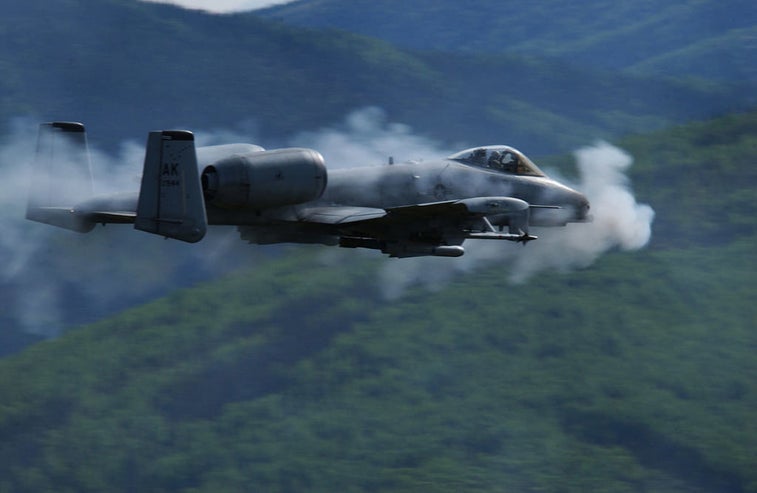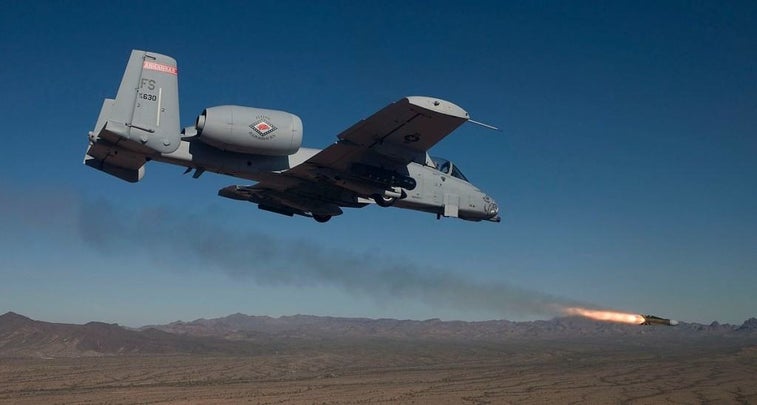There are plenty of weapons systems that ground troops want in support of high-risk missions, but few are as beloved as the A-10. The “Warthog” can fly low, take an amazing amount of punishment, and unleash absolute devastation on enemy forces with rockets, bombs, and its famous 30mm cannon.
The A-10 earned this reputation under fire. Here are five times that A-10 Warthogs saved the day for troops in contact and pilots lost behind enemy lines:
1. An A-10 coordinates support of a high-value target capture mission with no notice

Capt. Scott Campbell and his flight were enjoying a no-fly day when the word came in that a senior al-Qaeda officer had been spotted. In less than an hour, the pilots had thrown a hasty plan together and gotten into the air.
Campbell and the A-10 pilots provided direct fires in support of ground forces and deconflicted the flight paths of F-14s and F/A-18s on the mission while also feeding reconnaissance information to the troops conducting the capture. When the target was secured, the A-10s escorted the helicopters home to end the 8-hour, no-notice mission.
2. Warthogs shut down Taliban attacks against a besieged Special Forces team

An Army Special Forces team stumbled into a Taliban ambush and called for help from Apaches and A-10s. Capt. Aaron M. Palan was on his fourth mission in the deployment and flew his jet into the fray, sending four GPS-guided munitions, three white phosphorous rockets, and 1,150 30mm cannon rounds into the camouflaged and fortified enemy positions.
When Palan’s flight lead went up to refuel, Palan led the Apaches on attack runs against Taliban ground forces, killing 20 to 30 enemy fighters and shutting down five ground assaults against the Special Forces team.
3. A pilot destroys Iraqi forces while rescuing a downed pilot

During Operation Desert Storm an F-14 pilot was shot down by Iraqi forces. Air Force Capt. Paul T. Johnson was flight lead for two A-10s sent to conduct search and rescue, the first time the A-10 completed this type of mission in combat.
Johnson flew the plane deeper into enemy territory than it had ever gone and dropped to 500 feet to spot the isolated American. He spent over three hours searching and destroyed an Iraqi missile site before spotting the pilot and killing an Iraqi truck that was approaching the pilot. The rescue was ultimately successful.
4. Pilots use their own A-10s as bait for enemy air defenses to save a downed pilot
After an American pilot was shot down over Serbia on Mar 27, 1999, Capt. John A. Cherrey led a flight of A-10s to find and rescue him. Cherrey and his flight had to proceed directly through Serbian air defenses and fly over surface-to-air missile batteries to reach the crash site.

The flight dealt with constant jamming, bad weather, and enemy aircraft to reach the pilot. When the pilot was found close to Serbian air defenses, Cherrey and his flight flew circles over other areas in the air defense ring to distract enemy radar from the real pick-up location. The choppers were able to pick up the isolated pilot and everyone headed home alive thanks to the A-10s.
5. A quick-thinking A-10 pilot prevented a fratricide during a frantic, joint forces mission
In Jan. 2007, a group of British Royal Marines assaulted Taliban forces in Jugroom Fort, an insurgent compound. The fight quickly went south and the British launched a desperate rescue attempt for an isolated, wounded Marine that relied on Marines riding Apaches back into the fort, covered by a B-1 bombing run and A-10 gun runs.
While the A-10s deserve credit for covering the ground troops and Apaches, their single greatest contribution was when the A-10 flight lead called for an abort of the first B-1 bombing run. The flight lead had heard the ground controller pass the target coordinates to the B-1 and had realized, working mostly from memory, that the numbers were actually the coordinates of the Marines. The lead then walked the controller through how to get the proper coordinates, working again from memory.
This article by Logan Nye was originally published by We Are the Mighty.



